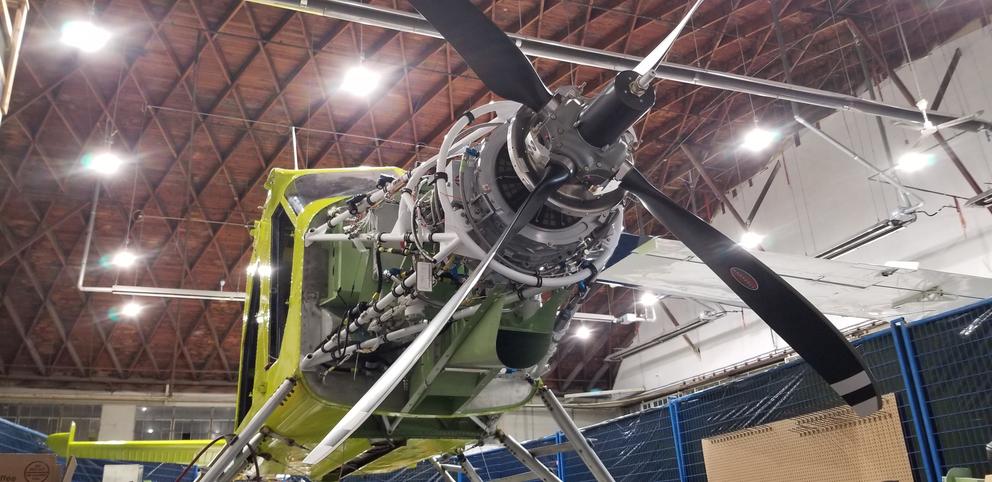But soon the Beaver might make history for what it promises for the future. Vancouver, B.C.-based airline Harbour Air and Redmond-based electric propulsion company MagniX are counting on the tried-and-tested reliability of this old plane to help commercial aviation reach a long-sought breakthrough: electric flight.
A 70-year-old plane might seem like a ridiculous place to solve one of green transportation’s biggest problems — a bit like attempting to transform a Model T into a Tesla S, only harder. But the perfect storm of aviation, startup culture and environmentalism in the Pacific Northwest offers an ideal incubator for the kind of innovation required for the challenge’s scale. Even electric plane companies not based in Seattle look to Washington state for suppliers and flight testing.
Credit Boeing and its ecosystem of suppliers, test pilots and spin-off industries. That ecosystem supports the ambitious partnership between MagniX and Harbour Air. Together, the two replaced the Beaver’s gas-guzzling engine with a quiet, carbon-zero electric motor. With flight tests beginning in Richmond, British Columbia, next week, this is poised to be the first viable all-electric plane for commercial air travel. (Ed. Note: Harbour Air's first electric flight test successfully landed in Richmond, B.C., on Tuesday, Dec. 10, 2019.)
“The entire ecosystem is built for an aerospace company,” said Roei Ganzarski, CEO of MagniX. “We wanted to create a hybrid company which takes the best of traditional aerospace and the best of start-up. Seattle is a phenomenal start-up environment, be it Microsoft or Amazon.”
The specter of climate change has added new urgency to developing commercial electric flight. Globally, nearly 2% of emissions come from airplanes, and those emissions will triple by 2050. While it’s not the largest contributor of CO2, it’s one of the fastest-growing sectors. Increasing calls to lower carbon output sparked an international flight shame movement, or “flygskam,” as it’s called in Sweden. Norway plans to have all short-haul flights be entirely electric by 2040. Fuel, beyond its environmental consequences, is one of the costliest expenses for airlines, and electric power is significantly cheaper.
Plenty of industry experts and scientists still write off large-scale electric flight as unworkable, and even those deeply engaged in the issue acknowledge that technological and business barriers remain high. But the idea of electric cars was thought of as a lofty dream worthy of mockery a mere two decades ago. Today, it’s hard to imagine any downtown street in America without Toyota Priuses and Teslas.
One of Harbour Air's seaplanes flies over Lake Union in Seattle on Aug. 13, 2019. (Video by Sarah Hoffman/Crosscut)
Tomorrow’s tech today
Harbour Air and MagniX join roughly 15 start-ups and companies attempting to tackle electric flight, each with their own spin: hybrid-electric, all-electric and other retro-fits. Uber is investigating electric air taxis. But for any to succeed they all must overcome the same basic hurdles.
Batteries are one of the biggest: The proliferation of electric cars has improved battery technology in the past decade, but batteries are roughly 40 times heavier than liquid fuel for the same amount of energy output. Cars can manage the weight on the ground, but an airplane must fight gravity to take off and stay in the sky. Once in the air, a plane gets lighter as it burns fuel. But batteries drain power and remain just as heavy as they were on takeoff. This leads to myriad complications, like needing heavier landing gear to handle the stress of landing with extra weight.
Batteries also take up to 20% more space than jet fuel, cutting into valuable cargo or passenger areas.
“Aviation fuel is basically just refined kerosene,” said Brian Corliss, aviation analyst with Leeham News. “Think of a gallon milk carton: You would need to get a milk carton that's 20 times bigger and would weigh 40 times as much [into the air].”
Currently, lithium-ion batteries have the best power-to-weight ratio, but they have a critical recurring problem: heat. The overheating batteries that have plagued terrestrial tech like the Samsung Galaxy Note 7, Tesla Model S and a generation of MacBook Pros could be absolutely devastating for planes: In 2014, Boeing grounded its entire fleet of Boeing 787s after lithium-ion batteries on the aircraft’s main and auxiliary power units caught fire.
“Electric motors produce heat,” Ganzarski said. “The higher the power, the higher the heat. So you could have a phenomenal motor that's very powerful, very lightweight, but requires so much cooling with a traditional cooling system that you've taken away any advantage that you've gotten.”
Many experts say battery technology is still at least three decades away from the needed improvements, barring a big chemistry breakthrough.
That’s not impossible: With more electric cars coming to the market, the technology is improving incrementally, said Dan Schwartz, director of the University of Washington’s Clean Energy Institute.
“Five or 10 years ago, I'd have laughed at the idea that [batteries] could take over in aircraft,” Schwartz said, “But now I think it is credible.”
Aviation: A brutal business
Right now, the technology industry is built on disruption of traditional industries — but the aviation might be one of the most difficult to disrupt.
First, it favors partnership and cooperation over go-it-alone piracy: Large manufacturers like Boeing or Airbus manage huge chains of suppliers, each making components for the aircraft as large as engines or as small as microchips. Each part and the aircraft as a whole have to be tested and certified — grueling processes that can take years to complete
“These start-ups are [...] dealing with investors who are used to making money in tech [where] they're getting returns in a matter of months,” Corliss said. “If you're going to invest in a start-up in this industry, you need to be patient, and you need to understand that you're going to be spending money for years before you see any return.”
Bothell-based start-up Zunum Aero had plans for a hybrid-electric 12-seat airplane that won investments from Boeing, JetBlue and Washington state in 2017. But all of that collapsed last year, when the company laid off most of its staff after struggling to raise sufficient second-round funding.
“What Zunum had tried to do [was] a super ambitious — I don't know that they really understood how ambitious it was,” Corliss said. “But trying to do it all yourself is a big, big chore. And I don't know how successful anybody is going to be with that.”

With the technological barriers so high, there’s something to be said for starting small. This is exactly Harbour Air’s plan: Its routes are mostly 30 minutes or less. The same model won’t work for most airlines, even ones with only slightly longer routes.
Since battery technology can’t power large commercial jets yet, many proposed electric planes are banking on the idea that people soon will fly short distances to thousands of small regional airports. Of the roughly 19,000 airports in the U.S., only about 600 are used by major airlines — and some think underused, smaller airfields are a transportation opportunity just waiting for a market.
“When people think about the future of efficient transportation, a lot of times people talk about high-speed rail,” Ganzarski said. “The challenge with them is the logistics. In order to have a high-speed rail between two cities, you have to lay railroad tracks between those two cities. The infrastructure in the United States for aviation already exists.”
The idea is to eliminate the drive to a big-city airport by flying directly to a small-town airport closer to your destination. While electric power can’t replace a cross-country flight, Ganzarski thinks it can cut down the CO2 produced in shorter routes normally taken by cars.
“Suddenly, Seattle to Pullman, Seattle to Spokane, Seattle to Ellensburg — just to name very short routes in this Seattle region — become a popular thing to fly,” he said. “Going to visit the in-laws over the weekend is not a huge burden.”
This business model has been tried before, and it didn’t take off.
“Even 10 years ago, there was a big talk about how carbon-powered, very light jets are going to revolutionize this market segment,” Corliss said, “We were all going to be hopping a taxi cab to fly to Spokane for the afternoon, and it just never panned out. It's not a high-demand market segment.”
For airlines, the economics of this kind of transit rarely made sense. Electric planes could make the difference: Taking a nine-passenger propeller aircraft 100 miles costs about $350 to $400 in fuel, Ganzarski said. The same flight would cost about $8 to $12 in electric power. Additionally, battery-powered engines have cheaper maintenance costs than a combustion engine because they have fewer moving parts. These savings could translate into cheaper ticket prices for electric flights, make the short flights enticing enough.
Despite the seemingly insurmountable obstacles, MagniX and Harbour Air have a partnership that just might work.
Something old, something new
Even for people like Ganzarski who are deeply invested in making electric flight happen, pivoting back to the success story of the electric car proves useful in getting people to see the potential.
Ganzarski drives an all-electric Kia Soul to work every day — fitting for an electric transportation entrepreneur. But he also owns a Ford F150. For him, it makes perfect sense: The electric car is for small, day-to-day tasks; the truck is for longer hauls.
“The electric Soul EV has a 110-mile range,” he said. “I can't do my drive with the family to Pullman. I can't take my trailer with me. I can't carry hay for my goats that we have at home and raise. So the electric car can't be used for everything. But it can be used for many things.”
Batteries aren’t good enough to power an Airbus A320 from Seattle to New York, and they might not be able to for a long time. For long-distance flights, biofuels and other technological advances could make a bigger impact sooner. But there are places where short flights make sense — and one of them is the Pacific Northwest. Harbour Air’s battery-powered Beavers can easily handle 30 minutes of flight time, plus an additional 30-minute reserve (required per safety regulations). Apart from the whir of the propeller, the electric motors on the retrofitted Beavers will be virtually silent. Harbour Air CEO Greg McDougall estimates that the “ePlanes” will produce 70% less noise in the air.
The plan for Harbour Air is to start with the trusty DHC-2 Beaver, and eventually convert the larger DHC-3 Otters that make up the rest of the fleet. They project the newly converted ePlanes will fly customers as soon as 2020. Harbour Air flies only the Cessna Caravan EX to Seattle, so the first batch of converted seaplanes will fly only within British Columbia.
“We're taking a marriage of new technology and old technology,” McDougall said. “Basically, the aircraft that we're flying have been around for many, many years, and for us to be able to retrofit with an electric engine kind of short circuits the whole development of having to build an aircraft around the electric motor ... which makes things extremely more simple in terms of certification.”
MagniX’s motor is designed to turn the propeller at the needed speed — eliminating the need for a heavy gearbox — and it has a lightweight cooling system. This gives the motor a better power-to-weight ratio.
MagniX CEO Roei Ganzarski explains the benefits of an electric motor. (Beatriz Costa Lima, Jen Dev, Sarah Hoffman/Crosscut)
MagniX’s 750-horsepower motor has already undergone 150 hours of testing with a propeller, and the new engines are installed on Harbour Air’s seaplanes, which were painted with a new green livery. Flight testing begins Tuesday.
“We don't know necessarily what could happen, where this could take us. We don't know all the questions necessarily to ask of what could go wrong,” Ganzarski said. “There's a lot of weight on our shoulders being first, but we are really excited that it enables us to really make this revolution a reality versus just a dream.”
Up in the air
While MagniX and Harbour Air’s retrofitted Beavers can get off the ground quickly, MagniX is also working toward designing an electric plane from scratch by providing motors for Israel-based Eviation’s electric nine-passenger jet, the Alice. Flight tests are planned for Moses Lake. Ganzarski is excited about the possibilities of experimenting with brand-new aircraft.
“You can do things that you can't do with traditional internal combustion engine,” Ganzarski said, “like put motors on the wingtips, like put a small motor on the tail to help propel, like having the entire aircraft be engulfed with batteries.”
Los Angeles-based Ampaire is retrofitting a Cessna 337 Skymaster with a hybrid propulsion system and plans to test it later this year on short routes in Hawaii. But McDougall says he wants to be the first.
“It's always the case that when you lead, people will follow in some form, but there has to be somebody to do it first,” McDougall said. “So I think just proving that it is actually is doable is a huge thing.”
Although small planes traveling short distances might seem like a minor accomplishment, McDougall and Ganzarski hope projects like theirs could be the spark that electric aviation needs.
“We really work here for the passion of changing the world,” Ganzarski said, “and the long game of being able to one day tell our grandkids that they take for granted flying electric planes because of what we did in 2018, 2019, 2020.”
Ambitious gambles like Ganzarski and McDougall’s are written into the origins of aviation. When brothers Wilbur and Orville Wright trekked up to Big Kill Devil Hill in the Outer Banks of North Carolina hauling a contraption that looked like a glorified glider, they tossed a coin to see who would take the maiden flight. Wilbur won, but his hopes were dashed when he oversteered upon launch and dove the aircraft into the sand. Three days later, Orville kept the first ever powered aircraft aloft for about 120 feet.
But what was most important happened after, as inventors and pilots around the world improved on the Wright Brothers’ attempt. Charles Lindbergh’s trans-Atlantic flight from New York to Paris happened less than 25 years later.
Correction: We corrected this story at 11:59 a.m. on Dec. 5, 2019, to reflect that Harbour Air flies the Cessna Caravan EX on its routes to Seattle, and not the DHC-3 Otter.





